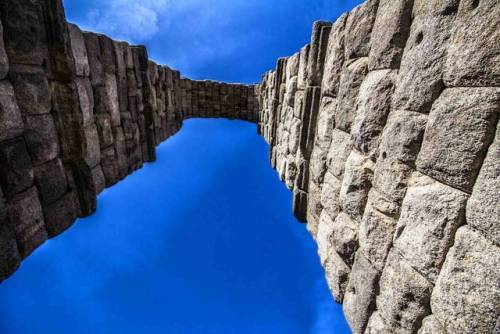#españa

Días

Noches

Noches

Días

Noches

Días

Días
Two State Solution for the Basque Lands in Northern Spain and Southern France
Dos posibles soluciones al “Conflicto Vasco”
Post link
(viahttps://www.youtube.com/watch?v=6om5nTVyQlg)
Num país de hipócritas, as putas ainda são as cidadãs mais dignas.
13/04/2022 Madrid, Spain, Europe.

13/04/2022 Madrid, Spain, Europe.

13/04/2022 Madrid, Spain, Europe.

13/04/2022 Madrid, Spain, Europe.


17/06/2020

17/06/2020
Tourism and Politics in Barcelona
by Melissa Vargas
The LIU Global Europe center visited the city of Barcelona, located in Spain’s autonomous region of Catalonia, for four days last month. Academic focuses of the trip included the study of Modernism and Surrealism, the politics of Catalan separatism, and the impact of tourism. An emphasis was placed on understanding the relationship between art, culture, and politics rather than viewing them as separate entities.
Political situation
The streets of Barcelona breathe political air. Everywhere you look, there are flags and political banners. Whether it be the Cataluñan independence flag or the Spanish flag, these flags serve as symbols of a deep-seated identity conflicts.
Personally, I found the topics of politics and tourism most interesting.
Politics

Catalonia has been considered an autonomous region by the Spanish national government since 1979. There are sixteen other autonomous regions in Spain, however, each region’s agreement with the national government and level of autonomy varies. Spain has granted Cataluña the right to self-governance and recognizes Catalan as an official language of the region in addition to Spanish. While Catalonia has been considered autonomous for almost forty years, a desire for greater autonomy and even succession has persisted throughout the region’s history.
At the mention of Catalonia, the first thing that might come to mind is the referendum that took place just over a year ago on whether or not the region should become independent from Spain. Although the Spanish state refused to acknowledge the legitimacy of the referendum, grassroots efforts still managed to make the vote happen. The referendum was met by the central government with violent and punitive responses, most notably raids on polling stations and both the incarceration and exile of Catalan government officials. While Catalonia’s turbulent political climate during the referendum caught international media attention, the coverage was ephemeral. Visiting Catalonia and learning about its history made clear that the region’s political unrest wasn’t born when global coverage of the referendum began, nor did it dissipate when the referendum ceased making global headlines.
The city of Barcelona breathes a political air, as distinct political flags and banners stuck out on nearly every street that I walked on. Some banners have messages advocating for the release of political prisoners by the Spanish government, while others simply have the word ‘sí’ printed on them in reference to the referendum vote. The different flags hung throughout the city give insight into the nuanced opinions that exist on the issue of separatism. The official flag of Catalonia is yellow with four red stripes. The popularly recognized Catalonia independence flag, which resembles the official flag but incorporates a white star within a blue triangle, was most prevalent throughout the city. Another flag, with the base of the official flag and a red star within a yellow triangle, also represents independence but has communist and socialist ties. I also saw Spain’s national flag hung as an expression of anti-separatism from time to time. Just walking the streets of Barcelona put into perspective the distinctions that exist even within parties generally in agreeance.
Tourism

Prior to the trip, our class discussed the negative impact of tourism within the city of Barcelona in our Bibliographic Research course. We particularly focused on the comparison of tourists to immigrants, in terms of their contributions to the city. Residents of Barcelona appreciate immigrants over tourists because they contribute to society in a lasting, impactful way. Imagining the specific ways that tourists might negatively impact a city, such as pollution and gentrification, was near effortless. However, one statistic from the Guardian mentioned during our discussion was inconceivable: Barcelona recorded 32 million tourists in 2018, which is 20 times the population of the city’s residents. For this class, we were tasked with being acutely aware of the impacts of tourism on the city throughout our visit and taking field notes on our observations.
There is a large immigrant population in Barcelona and it quickly became clear why the city prefers their presence over the presence of tourists. Over the span of our four day trip, I encountered and spoke with a Colombian woman who works in a shoe store, a Pakistani restaurant owner, and a woman running an art exhibit from Madagascar. The immigrants I encountered are all individuals who are in Barcelona to stay, whereas tourists are not.
The once unfathomable number of 32 million tourists truly came alive upon arriving in Barcelona. Streets, public transport, and famous landmarks are heavily congested with tourists. In our Global Studies course, we’ve been learning about the concept of space and how to analyze it. What better place to analyze space than Barcelona? I found the Barrio Gótico quarter, a heavily commercialized area located in the center of the city, a particularly interesting space to analyze. Contrary to its name, Barrio Gótico is not authentically gothic; the quarter’s medieval buildings were restored in a gothic style during the late 19th and early 20th centuries in order to appeal to tourists.
As I walked through the quarter knowing its history, I couldn’t help but feel like I was walking through an artificially constructed space. Endless modern shops and restaurants, nestled along cobblestone alleyways and next to large gothic buildings, seemed rather incongruous. The quarter consists of many tall buildings with balconies overlooking the narrow streets below. From these balconies hang independence flags and political banners. While independence flags were hung from a minority of the balconies, the symbolism of these flags exudes a very political climate into a space largely occupied by tourists. It was interesting to see small, spatially elevated expressions of residentiality and local identity juxtaposed with the predominantly tourist-filled space below. It’s difficult to imagine, as a local, looking down onto a space every day that tourists dominate.
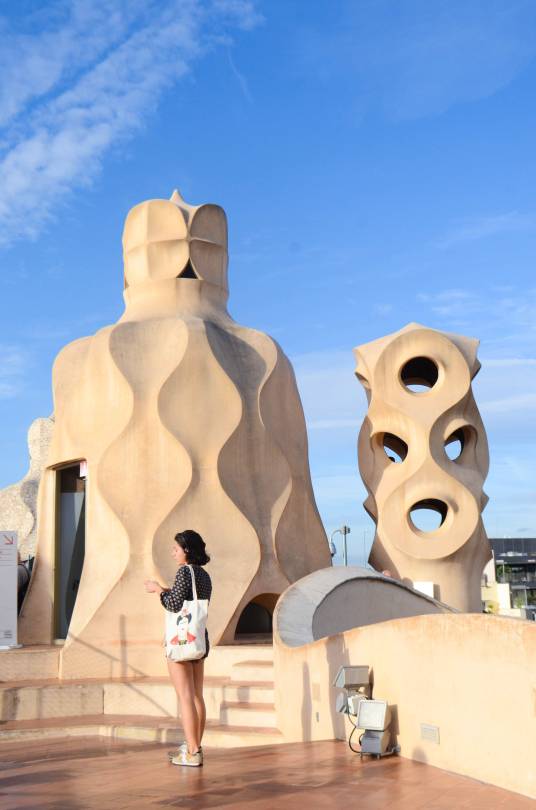
While there isn’t a simple solution to the issue of tourism in Barcelona, witnessing how tourists can negatively impact a society causes me to question my role as a traveler and think more deeply about the way I may be affecting a city when I visit it.
Post link

Just one week after touching down in the Spanish city of Alcalá de Henares, a UNESCO World Heritage Site that we are lucky to call our very own campus, the students of LIU Global’s Europe center set out for Spain’s northwest community of Galicia to commence walking the Camino de Santiago. The early morning five-hour train ride to Galicia carried us away from the urban hustle and bustle of the greater Madrid area, as we coasted along vast farmlands and quiet villages.
The Camino de Santiago, more commonly known as “El Camino”, is a pilgrimage walk leading to the magnificent Cathedral of Santiago de Compostela where the apostle St. James is thought to be buried. During the Middle Ages, most pilgrims had religious motives for completing the Camino, particularly the promise of total redemption from all sins; nowadays, the walk has a variety of non-religious meanings for people from all walks of life.
The Camino consists of various routes spanning both throughout Spain and across surrounding Europe. While the cathedral serves as a definite marker of the walk’s endpoint, both the route and total distance walked are unique to each person. Our class walked forty kilometers through the towns of Arzúa and O Pedrouzo over the span of two days, but others sometimes dedicate an entire year to walking much longer routes.
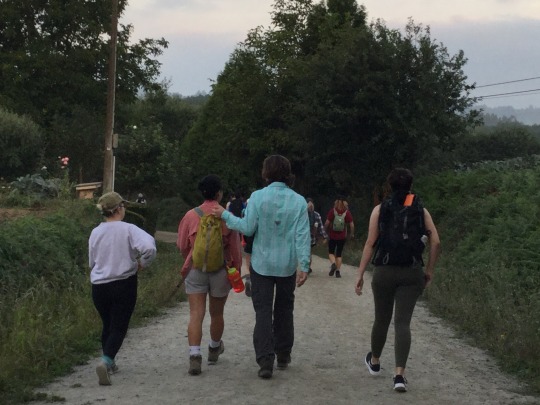
The Camino holds a different meaning for everyone that walks it. My classmates and I sought out to explore both what significance it holds for us, as well what it means to others walking. The walk is very much a no-frills experience: basic hostels, limited access to technology, and fitting all your belongings into a single backpack. Nevertheless, the lack of luxury is precisely the reason many people are drawn to the journey. The Camino exemplifies how instrumental forfeiting material concerns can be in creating an authentic space for internal reflection and meaningful interaction with others.
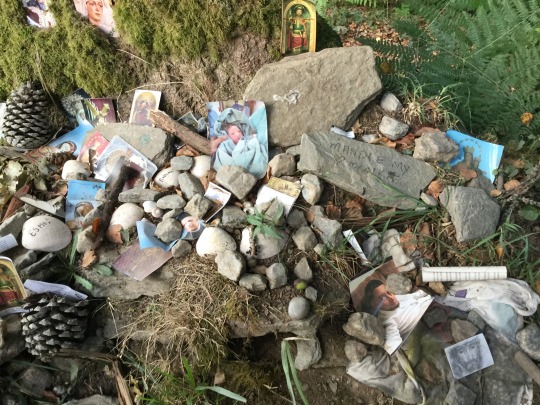
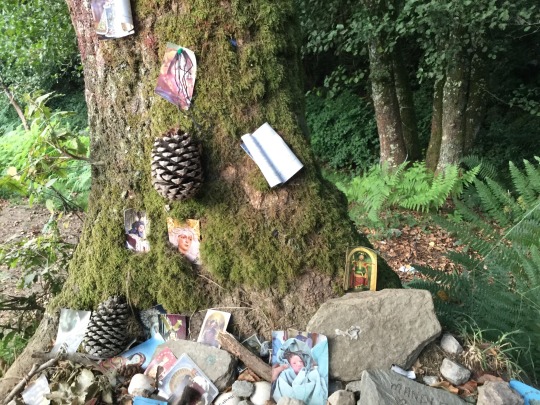
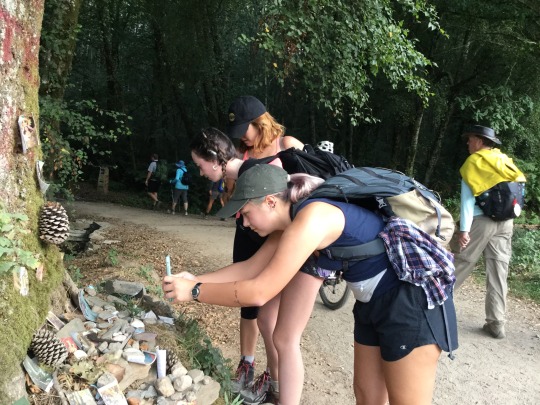
Just as each morning’s crisp air and morning dew eventually faded as the day went on, my discomfort and often trivial concerns dissipated as the days of walking progress. I instead became absorbed by the scenes of small brightly colored homes, farm animals, beautiful flora, and messages of encouragement scribbled everywhere. One message read, “viajar abre la mente”, which translates to travel opens the mind. While quite simple, I think this message truly embodies the Camino’s spirit of mental growth. The walk’s long dirt trails guided me through lush farmland and rich forests, but more importantly to an untapped mental space of reflection and gratitude. The journey gave me both the time and space to reflect on the past couple of months of travel throughout Europe and appreciate how fortunate I am to immerse myself in global experiences as meaningful as walking the Camino.

The Camino held a special meaning for each and every member of the LIU Global Class of 2021. Classmate Lilli Hoffman also found the experience to be a meaningful space for reflection. She says, “It was a time that I could spend a few days in nature quietly reflecting on the year previous and the year ahead. It made me feel like I was part of something a lot bigger than me, something that millions of people had walked before me. Just walking brought me a lot of clarity and made me want to go back and do a larger portion Camino in the future by myself.”
For Skylar Silvera, the Camino’s spirit of community was most meaningful: “Meeting people from all over the world, learning about different beliefs and hearing stories about loved one’s travelers dedicated their pilgrimage to, was such a beautiful experience that I know all of us to cherish deeply. Now I get to look back on these miles and think of the many before me that yearned to journey outside their tiny villages to seek a greater unknown, and feel lucky that I get to do that every day with the best people.”
While the Camino meant something unique to each of my classmates, I’m sure the experience will never fade from each and every one of our memories. In fact, many of us hope to return one day and challenge ourselves with a longer route. Before attending LIU Global, the Camino was something I had always heard about but never thought I would ever realistically have the opportunity to do. Needless to say, the Camino was such a meaningful addition to the Spain program this year and surely will continue to be in the years that follow.

Segovia a las sombras del acueducto #segovia #españa #cielo #nubes #sky #sky☁ #sky #clouds #azul #blue #igers #igerssegovia #igersespaña #canon #canon #canonstreetshot #canonshot #canonshoot #60d #streetshot $streetphotography (en Acueducto de Segovia)
Post link
Piedra sobre piedra Acueducto de Segovia. Lookup. #segovia #españa #acueducto #aqueduct #piedras #stones #arch #arco #romano #igers #igersespaña #igerssegovia #azul #blue #lookup #picado #canon #canonshot #canonshoot #canongallery @canon.shoot @canon_photos @canongallery (en Acueducto de Segovia)
Post link





